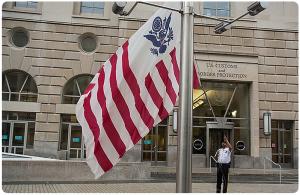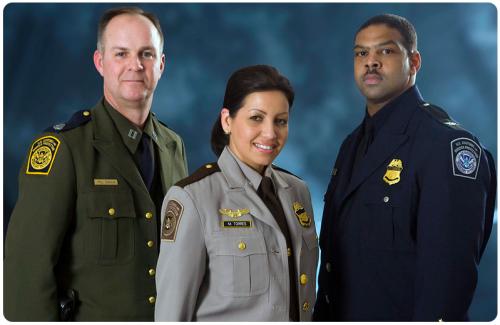Celebrating landmark events from CBP’s first 20 years.
On March 1, 2003, U.S. Customs and Border Protection was established as the nation’s first comprehensive border, travel and trade agency. The agency’s formation was a direct result of the recommendations of the National Commission on Terrorist Attacks Upon the United States, known as the 9/11 Commission, and was established within the newly formed Department of Homeland Security.
The agency integrated four legacy agencies. The Customs Service, which was transferred from the Treasury Department, originates from the Fifth Act of the First Congress on July 31, 1789. Immigration inspection, from the Immigration and Nationalization Service, traces its roles to the establishment of the Office of the Superintendent of Immigration on March 3, 1891. INS also housed our enforcement functions, including Border Patrol, which was first authorized by Congress on May 28, 1924. The plant protection and quarantine inspection programs, from the Animal and Plant Health Inspection Service in the Department of Agriculture, traces its agriculture inspection roles to the passage of the Plant Quarantine Act on Aug. 20, 1912.
The agency’s mission is to protect the American people, safeguard our borders, and enhance the nation’s economic prosperity. With more than 60,000 employees, CBP is one of the world’s largest law enforcement organizations and is charged with keeping terrorists and their weapons out of the U.S. while facilitating lawful international travel and trade.
As the nation’s first unified border entity, the agency takes a comprehensive approach to border management and control, combining customs, immigration, border security, and agricultural protection into one coordinated and supportive activity.
-
CBP’s Core Values
- Vigilance is how we ensure the safety of all Americans. We are continuously watchful and alert to deter, detect and prevent threats to our nation. We demonstrate courage and valor in the protection of our nation.
- Service to Country is embodied in the work we do. We are dedicated to defending and upholding the Constitution of the United States. The American people have entrusted us to protect the homeland and defend liberty.
- Integrity is our cornerstone. We are guided by the highest ethical and moral principles. Our actions bring honor to ourselves and our agency.
CBP’s Enduring Priorities
Counter Terrorism – Anticipate, detect and disrupt the threat of terrorists, their weapons and actions to protect the people and economy of the United States.
Combat Transnational Crime – Detect, deter and disrupt transnational organized crime that threatens U.S. national and economic security interests at and beyond the border.
Secure the Border – Protect the Homeland through the air, land and maritime environments against illegal entry, illicit activity or other threats to uphold national sovereignty and promote national and economic security.
Facilitate Lawful Trade and Protect Revenue – Enable fair, competitive and compliant trade and enforce U.S. laws to ensure safety, prosperity and economic security for the American people.
Facilitate Lawful Travel – Enhance, enable and transform the travel experience by anticipating, detecting and intercepting threats prior to and at ports of entry.
CBP’s History
CBP’s traces its historic beginnings to 1789. But it was the tragic events of 9/11 that forever changed the nation and later forged CBP into the evolving agency it is today. Since the agency’s establishment 20 years ago, CBP has continued to grow stronger, more dynamic and capable of taking on our nation’s most important challenges.
Container Security Initiative Launched to Protect Global Trade, Enhance Border Security
CBP launched the Container Security Initiative (CSI), one of the most critical parts of the agency’s layered cargo security strategy, in the wake of the September 11, 2001, terrorist attacks on the United States.
Air and Marine Operations’ Unmanned Aircraft System
In 2005, CBP began using the MQ-9 Predator B Unmanned Aircraft System (UAS) – marking a leap forward in the use of unmanned systems for CBP.
Celebrating U.S. Customs 234th Anniversary
July 31, 2023, marks the 234th anniversary of the birth of the U.S. Customs Service and the important role it played in the history of the United States.
The Unveiling of U.S. Customs and Border Protection’s Valor Memorial
In March 2004, CBP’s Valor Memorial was unveiled at its headquarters in Washington’s Ronald Reagan Building. The Memorial is a tangible sign of CBP’s continued commitment to honor the agents, officers and employees who lost their lives in the line of duty.
Border Patrol Academy Unified in Artesia
When class session 583 reported to the Border Patrol Basic Academy in Artesia, New Mexico on October 20, 2004, it marked the beginning of a new era in U.S. Border Patrol training history.
Trade Facilitation and Trade Enforcement Act Brings Sweeping Change
The Trade Facilitation and Trade Enforcement Act of 2015 (TFTEA) was the first law since the Department of Homeland Security's inception in 2003 to grant U.S. Customs and Border Protection (CBP) comprehensive authority to ensure a fair and competitive trade environment.






